 |
|||||||||||||
 |
|||||||||||||
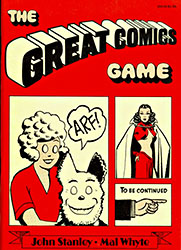
The Great
Comics Game
THE GREAT COMICS GAME (1966)
THE GREAT COMICS GAME was a collaborative effort with Malcolm Whyte, the man who ran the now famous Troubador Press in San Francisco. We first met through our mutual interest in comic books, and Malcolm and I were to become close friends. He went on to publish the "Fat Cat Coloring Book" series and scores of other popular novelty and game books over the years, becoming one of the most successful San Francisco-based publishing houses of all time. Malcolm later started up the Cartoon Art Museum of San Francisco and today is still its number one curator. We remain to this day the best of friends, and he has given me much inspiration and guidance for many of my publishing ventures. Because of Whyte's knowledge of other publishers and his many contacts in the publishing world, he was able to convince Price/Stern/Sloan of Los Angeles to buy our idea for a quiz book about the world of comic strips and comic books. We heavily illustrated the book with drawings of famous superheroes and comic-strip characters and ran credit lines under the art, so the publisher must have been granted permission by the various comic book and strip artists of the time. I have little memory of helping Malcolm write this book or who went to the trouble to gather all the permissions needed.
Although Price/Stern/Sloan was known for selling hundreds of thousands of copies of some of their humor books, THE GREAT COMICS GAME was a modest success in the bookstores. It's only significance to me today is that it "launched" my career as a publisher author, and forged a friendship with an important San Francisco publisher that remains solid today. Call it the first stepping stone in one of my many mini-careers.
看
WORLD WAR III
aka: NAPALM SUNDAY
WORLD WAR III was my first published fiction and it was a labor of love with a colorful history. I had originally conceived of the idea of having military characters trapped behind enemy lines during a non-specified war. The idea was to satirize Hollywood's combat, trapped-behind-the-lines movies. A major inspiration was Samuel Fuller's 1951 Korean War movie, THE STEEL HELMET, and his follow-up film, FIXED BAYONETS, the 20th Cent;ury-Fox classic that launched his career as a studio director. The first version of my idea was a short script designed to be made in 16 mm. When this never came to fruition, I decided to expand it into a full-length war satire and wrote a screenplay called SARGE that I submitted to Adam West. I had met and interviewed West twice when he was doing the BATMAN series for ABC-TV, and he had told me after the series left the air that he was looking for scripts. Being an open and warm person, he listened intently as I described my war-film idea. He read and loved SARGE, feeling it was completely different from anything he had ever done, and would help him to break away from the typecasting he feared that the Batman role had strait-jacketed him in. He spent a year looking for a producer, and was constantly turned down. He called one night to say the title would have to be changed, as there was a new TV series called SARGE starring George Kennedy.
Finally, frustrated and tired of the whole thing, he turned the script over to Burt Ward, who had played Robin opposite him in the successful TV series, for he felt there was a role in the script (a greenhorn named Youngman) that fit Ward. But Ward had no luck either so in 1972 I turned the screenplay into a full-length novel. It was a satire on war novels and movies, set during a full-scale war between the U.S. and China, with American soldiers entrenched in the hills of China. Some of the inspiration for my character of Sarge (an eternal, ageless NCO who seemed to possess combat skills gathered from wars all the way back to Napoleonic battles) came from Sergeant Zack of Fuller's THE STEEL HELMET. My new manuscript featured stories-within-stories, war "yarns" Youngman was writing on his field typewriter, and other oddities of narrative. I had also recycled some old short stories I had written during my years as a liberal arts student at San Francisco State College, seeking a B.A. degree. It was definitely an oddball book . . .
I didn't have an agent at the time and picked up a copy of Writer's Digest, looking for potential publishers. I found an a-to-z list of New York companies. The first name on the list was Avon Books, so I sent the manuscript off unsolicited, "over the transom" it's called. Let me explain that WORLD WAR III was never the title I had given the book. The screenplay marketed by Adam West had been called SARGE. The new title, when I submitted to Avon, was NAPALM SUNDAY.
To my utter amazement, I received a phone call one night a few weeks later from an editor who wanted to buy my book. It was purchased in the fall of 1974 by Avon, and published in early 1976. But not under the title NAPALM SUNDAY. This title was deemed too politically incorrect by Avon, and WORLD WAR III was substituted. I think that was a big mistake. Whatever, it was a title I never liked.
The rights for the British market were picked up and a second edition of the book, featuring a different cover, was released in 1977. I immediately wrote a sequel, SON OF SARGE, but it was deemed too convoluted and became one of the great disappointments of my life. And convinced me that I was probably not going to be the greatest fiction writer on Earth, as I had once dreamed. My fiction was hit and miss at best.
看
THE MONSTER MOVIE GAME
By Malcolm Whyte and John Stanley
This marked my second collaboration with Malcolm Whyte of Troubador Press. Like THE GREAT COMICS GAME, it turned out to be a modest quiz book that had modest success in the novelty book field. It featured photographs of horror film stars and scenes from assorted science-fiction and horror features. Another minor footnote to my life and career.
看
THE DARK SIDE
The next novel, THE DARK SIDE, published in 1977, was written in collaboration with Kenn Davis, a long-time friend and Chronicle co-worker with whom I also co-made the 1978 feature film NIGHTMARE IN BLOOD. Prior to making NIGHTMARE, Kenn and I had collaborated on several TV and novel projects but they all fell by the wayside. Although DARK SIDE was our first creative-writing success, it had not started out to be a novel. Around 1969-70, it had been Kenn's idea to write a screenplay about a black San Francisco private eye named Carver Bascombe, entitled DARK SIDE OF THE HUNT. He ground out the original script and I came along behind him, helping where I could.
Once the script was finished, we showed it to a San Francisco-based black actor, John Cochran, who seemed born to play Bascombe. Known primarily for his stage work, Cochran loved DARK SIDE OF THE HUNT and agreed to play the leading role, and also became a partner . . . meaning we would all be equal producers should we find the money to make the film.
However, prior to meeting John we had sent the script to American-International Studios in Los Angeles. Soon after, the phone rang - AIP wanted to see us about buying the script. So Kenn and I flew to L.A. to meet executives who told us they wanted to produce our story. But they rejected our proposal that we hire on as co-producers, and John Cochran play the Bascombe character. AIP wanted to have nothing to do with any of us. All that was wanted was the screenplay. In one of the dumbest decisions of our lives, Kenn and I turned down the offer. We were bound and determined to make the film ourselves. And we felt obligated to maintain our handshake deal with John. (If only we had accepted the offer . . . what happened after that is one for the books of ironic twists.)
The next thing I remember, Kenn and I decided to shoot some sample footage in 35 mm which we could then show to money sources, and perhaps get the film made as we envisioned it. About this same time, we approached American-Zoetrope, the headquarters of Francis Ford Coppola and George Lucas in the wake of them making "THX 1138." Word was out around town that Zoetrope was looking for scripts from local writers and might provide financing. Coppola was away making "The Godfather," and had left a young employee in charge of the facilities on Folsom Street. We left a script with him and soon were told to come over and "take" a meeting. We schmoozed with the young executive in charge, whose name I will not reveal, to spare him any embarrassment. (Even if he deserves to be embarrassed . . . ) He told us he liked our screenplay very much and Zoetrope would finance the film. He gave us permission to use Coppola's editing facilities where we could cut our sample 35 mm footage. This was a flat-bed state-of-the-art editing machine and we reveled in all the excitement of being "on the cutting edge" of modern film making. We cut our film at Coppola's own editing machine one night and eagerly anticipated our next meeting at Zoetrope. However, it soon became obvious that we were persona non grata, as the executive refused to return our phone calls. We realized we had been lied to and were feeling miserable about it. Especially with the AIP deal having been turned down.
One afternoon I read in the San Francisco Chronicle, in Herb Caen's column, that Coppola had returned to San Francisco and would be in his office for just a few days before leaving to shoot more footage for "The Godfather" in Sicily. On the spur of the moment, I told Kenn we should walk the two short blocks from the Chronicle office to Coppola's headquarters on Folsom. It was a warm day and we strolled toward Folsom, wondering how to confront Coppola with what was happening. And would he even be willing to speak to us, assuming he was there?
We got very lucky, or unlucky, depending on your viewpoint. Coppola was in his office and agreed to see us, sight unseen. None of us had met before. Kenn and I spilled out our hearts about being told our film was on the Zoetrope production charts, and yet we had been ignored by the executive in charge. Coppola listened patiently, then began to dab his eyes with a handkerchief. Tears spilled down his cheeks as he acknowledged that he had left the executive in charge during his absence - but that he had not given that person any powers to make choices about film projects. The exec had misused his authority in telling us we were going to be part of the Zoetrope production team, and Coppola had already fired him, having heard similar stories of his misuse of his position. Dabbing away additional tears, Coppola told us he had absolutely zero interest in THE DARK SIDE or us. We thanked him for his candor and left the office. (The fired employee actually went on to become an associate producer in Hollywood for a low-budget film company. For years afterward we would see his name on the credits of schlocky sci-fi and horror films, many of them made overseas in Israel. Kenn always cursed under his breath and vowed to bust his arms and legs should their paths ever cross. They didn't, and the executive's bodily functions continued uninterrupted.) DARK SIDE OF THE HUNT never got produced, and internally I wept over turning down the AIP offer. Life's decisions don't get any dumber. Bittersweet bittersweet bittersweet.
A few years later, Kenn and I decided to turn the project into a novel. Or at least Kenn did. I think all I did was make some plot suggestions and edit the text a few times. We submitted it to the same editor who had purchased WORLD WAR III, and Avon brought out an edition that sold very modestly. Kenn and I were nominated for an Edgar award that year, but didn't win. If we had, I would have had to confess that it was really Kenn who won the award, since DARK SIDE had always been his dream baby. By then SHAFT and the black private detective cycle had passed. We had missed our chance. Had we accepted American-International's offer, DARK SIDE might have been the first of the black private eye movies, beating SHAFT to the draw. Kenn went on to write single-handedly several Carver Bascombe novels published by Avon, but I wasn't all that good at dealing with the private-eye genre, and stepped back from collaborating on the series. However, Kenn and I were to work on one more novel together.
看
Bogart '48
In late 1976, I had conceived the idea for a novel set in Hollywood, starring the great Humphrey Bogart. I called it BOGART '48, choosing to set it in the year 1948 when Bogart sets out with his friend Peter Lorre to solve a mystery surrounding the pending Academy Award show at Shrine Auditorium. Kenn and I discussed a possible plot and with only the barest bones of that plot, I submitted a brief outline to my agent in Hollywood, who had tried to see my novel WORLD WAR III to the movie world without any success. My outline was in the form of a fast-paced Madison Avenue sales-pitch approach. It was a lot of hype that worked. The same week my agent received the proposal he was having dinner with an editor from Dell Books, and laid the proposal on the dining room table for him to read. By the time they had finished the meal, the New York editor had committed to the project, as long as we could come up with a suitable plot outline, to be submitted as quickly as possible in synopsis form.
Kenn and I celebrated the Christmas of 1976 with our literary victory, not realizing we were facing a three-year ordeal before we would ever see a book in hand. We concocted what I thought was a clever plot in which real-life characters (such as Harry Cohn, Marilyn Monroe, John Huston, Max Steiner, Hedda Hopper, Ray Teal and others) were blended with fictional characters. (All the male fictional characters, by the way, were given names of people Bogart had played in assorted films) We submitted a first draft many months later, but the manuscript was overwritten and desperately in need of condensation, and our publication date was set back. So we set out to cut it as much as we could. I was really struggling through this period, holding down my Chronicle job, enduring some eyesight problems and in general finding out I wasn't as good a novelist as I had hoped. Kenn struggled with me and provided good guidance. I doubt I would have completed the project without his professionalism as a writer. We finally finished up most of the work by the end of 1978, but still faced another year of waiting while Dell got the project back into the lineup.
Finally, in 1980 the book hit the stands. It never seemed to take off, although I still think it's one of the best collaborative efforts between myself and Kenn Davis. My L.A. agent had so hated the first draft that he pretty much washed his hands of associating with me again. Ah, the ups and downs and life. However, Kenn and I were to work on one more novel together.
看
VIVA KNIEVEL
Novelization of the 1977 Feature Film
During the three years of working on BOGART '48, I also completed a less formidable challenge by writing the novel-length adaptation of a screenplay for Avon Books. The film was entitled VIVA KNIEVEL, which had been written for the screen by Norman Katkov from a story by Antonio Santillan. It was a contrived, less-than-great fictional story centered around daredevil Evel Knievel, which turned him into a kind of hero. It was a colorless screenplay, with hardly any characterization. And seemed to have little to do with the real-life Knievel. I decided a book version would need a lot of true-life detail to bring it to life, but my editors at Avon told me Knievel didn't want any such detail. Don't tinker with the script. I asked if I could interview him for background material I would then weave into the book, but the daredevil refused to talk to me. I was to stick to the script's action and to hell with everything else. Given that the screenplay had absolutely zero personality or motivation, it was a hopeless task. The book was released in 1977 simultaneously with the film, which was a complete stinker bomb directed by Gordon Douglas. It crashed and burned instantly. They had allowed Knievel to portray himself, and he was a lousy actor.
Old pros Gene Kelly and Red Buttons couldn't save the day or anything else. It had the additional benefit of Cameron Mitchell and Leslie Nielsen, and not even those pros looked very good in it. The whole thing was a misfire. My heart went out to other stars Lauren Hutton, Frank Gifford, Dabney Coleman, Albert Salmi and Marjoe Gortner. Gobble gobble gobble. At least I had rather enjoyed the challenge. I had to finish it in a matter of weeks, and met the deadline. So I had at least done my job, even if the screenwriters hadn't. A once-in-a-lifetime experience.
看
LOST IN TIME AND SPACE
WITH LEFTY FEEP
By Robert Bloch
Edited by John Stanley
Introductions by Chelsea Quinn Yarbro and John Stanley
Editing and publishing LOST IN TIME AND SPACE WITH LEFTY FEEP proved to be far more pleasurable, given the sense of humor of Robert Bloch, but no more profitable than THEM ORNERY MITCHUM BOYS. I was in Los Angeles in 1986 with a few hours to kill so I drove to Bob's home in the Hollywood Hills. I had interviewed him on several previous occasions for the Chronicle and once for Castle of Frankenstein magazine, and he had always said his door was open to me. He welcomed me and I proposed the idea to anthologize his short stories about a race track tout named Lefty Feep. These stories had been printed in pulp magazines in the mid-1940s and, although much talked about among fans, had never been reprinted since. Bob and I shook hands on the deal, but he warned me: "You realize you're never going to make a cent on this book, right?" The final edition, published in the spring of 1987, contained eight reprinted short stories, and one brand new tale Bob did just for the book. I also interviewed Bob at some length and wove his comments about each story throughout the book. I further penned a lengthy introduction, writing in Bob's satirical style to capture the essence of the great creator of PSYCHO. Chelsea Quinn Yarbro, the fantasy-horror writer, also wrote a nice introduction for the book. With endorsements from people like Ray Bradbury and Harlan Ellison, I thought I had a fighting chance . . . but alas, the book sold poorly and it took me years to unload most of the 5,000 copies stored away in my garage. There are still a handful left, and if you would like to order one . . .
看
THEM ORNERY MITCHUM BOYS
By John Mitchum
Edited and Published by John Stanley
I had first met John Mitchum (the brother of Robert Mitchum) in San Francisco in 1976 when he was playing Inspector Frank Giorgio, the partner of Dirty Harry, in "The Enforcer." It was the third and final picture in which he would co-star with Clint Eastwood in the series, as he is killed off halfway through the picture. It was just another interview at the time and I never thought I would meet John again. However, Mick Martin, author of the VIDEO MOVIE GUIDE paperback series, called me from his home in Sacramento in 1987 and told me that John had written a manuscript about how he and his brother had grown up battling other kids who frequently challenged or attacked them. The narrative included the history of Robert's movie career, and how John himself was featured in 30 motion pictures and about 300 TV shows. Mick Martin, aware of my self-publishing efforts and enamored of the manuscript, felt I might like to read it. The manuscript was tattered and needed a lot of work but I saw possibilities for the book, especially if it was heavily illustrated with photos. I contacted John and we made a book deal, contract and all. Almost immediately, John asked for an advance against royalties to come. Although I didn't have to give him any more money, I went ahead and did so. Feeling a little uneasy about it. I asked John to do a lot of revision work, which at first disappointed him.
He thought he had turned in a "perfect" manuscript. Finally, he got into the swing of things. While he revised, I gathered photos from countless sources, and eventually would have 300 pictures for the book, many seeing print for the first time. I began laying out the book page by page. From the beginning, John had unrealistic expectations and kept talking about enormous sales. I tried to tell him I was printing only 5,000 copies and chances for wide distribution were modest at best, but he kept fantasizing about a best-seller. Reality was never one of John's strong points.
I soon discovered John was a hopeless alcoholic, so I started putting the bits and pieces he gave me into chronological order to bring some sense to the chaos he had created at the typewriter. Christmas of 1987 he came to the house for a special party, bringing his guitar with him. John had originally struck me as a charming man with a gentle manner. He was great at playing guitar, especially with the songs he had written the lyrics for and I had asked him to entertain my guests. At the front door he told me he wasn't drinking. But a half hour later asked for his first drink. And then another. He continued nonstop. By the time my guests came, he was passed out in a chair in my front room. "Who's the old guy asleep over there?" more than one guest asked me. I felt my first pangs of doubt - was THEM ORNERY MITCHUM BOYS going to be my undoing? - as John's wife Bonnie and I somehow carried him from upstairs to the bedroom downstairs.
One night in Penn Valley, where John lived with his wife Bonnie at the time, we were having dinner when John told me the story about "brother Bob" and his arrest in 1947 for drug use. This had been a major media event making front-page headlines. Bob had been sentenced to jail, ending up on an honor farm. Predictions were made that his movie career would be over, but instead it seemed to bring him even greater popularity when he began making movies again. It was part of the Mitchum legacy everyone talked about, and I pointed out to John he had failed to put much into the book about this event. John got very maudlin and told me the real story of how Bob was arrested.
Shortly before the 1947 event unfolded, John's mother had called him and pleaded with him to stop Bob from running with a motley collection of characters in the Hollywood Hills who were holding drug parties and sex orgies. Bob, the mother said, was going to destroy his career. And John had to do something to stop him. John promised her he'd take care of matters. Relax, mama, I'll handle this. But John was stymied when he hung up the phone. John told me, "I didn't know what to do. I knew talking to Bob would do no good. He'd never listen to me and change his ways, and we had the kind of relationship where I wouldn't have asked him to do anything. So, I did the only thing I could do. I called the police and tipped them off to the hour and place of the next sex-drug orgy. The cops were waiting and arrested Bob. I figured that would stop him. Yeah, maybe I was betraying him, but it was for his own good, wasn't it?" I told John he had to tell this story in the book. It had never been told before. It would make for a good selling point. John shook his head. No way was he going to embarrass his brother about this old chestnut from his past. It was then I realized that John was never going to tell the full story about his brother, and the book would suffer as a result. As many times as I tried to cajole him, he refused to co-operate. But now you know the rest of the story. It took me a full year to edit and lay out the book.
It was finally published in the summer of 1989. There were 200 hardcover editions signed by John and Bob that vanished very quickly, but the trade paperback was only modestly successful. I blamed part of the book's failure on John's refusal to include all the truth - had he done so, I think THEM ORNERY MITCHUM BOYS would have done much better. But as it turned out, it took me ten years to unload the 5,000 trade copies. (Unfortunately, it is now sold out.) In the beginning, John and I had a gentleman's agreement that he could take boxes of books and sell them, and then he would pay me my share out of the monies collected. A great example of the tail wagging the door. And a sign of my business naive. This odd arrangement worked for the first few months after the book came out. But then John refused to give me any money. "I need it worse than you do," he told me on the phone one night, hanging up a moment later. Eventually it turned out that John, by keeping money owed to me, had made more residual money than he should have. Beware handshake deals. Or so called gentleman's agreements. One of the parties might not be a gentleman. I sent John a letter, telling him he could still have books from me, but he would have to give me a check for them upfront, based on our original agreement. For some inexplicable reason he refused to contact me after that. It was his loss, I thought.
We never spoke again for the next ten years.
During that time he sicced a lawyer on me, who demanded more residual moneys. I hired my own lawyer who sent the prove that John had been paid more than he was entitled to. One day John, possibly in a drunken state, confronted his lawyer and demanded he do something. The lawyer fired him as a client on the spot. A year or so later John sicced another "lawyer" on me, an individual from Sonora who turned out to be anything but a lawyer. I told this person that I would still sell books to John at the agreed-on rate, but the individual told some lies to John and John found out and threatened to punch him in the nose.
Finally, John called in 1999 and asked for some books for a special show in Sonora, CA, where he lived. He came to the house one day in a van driven by a friend. As they sat in my front room, exchanging small talk with me, I proposed that John and I have one final drink. John said he would like a drink but it wasn't going to be our final one. There would be more. Our friendship was going to resume, and grow.
We had that drink and I knew it was our last drink together. Period. And John and his friend drove off with the last 75 copies of THEM ORNERY MITCHUM BOYS. He never called again. I never saw him again. He died of a stroke in November 2001 at the age of 82. It had been a less-than-pleasant experience. And yet to this day I don't regret publishing John Mitchum's memoirs. It contains many excellent vignettes and anecdotes about Hollywood, and it will always stand as an important historical monument to the career of Robert Mitchum, who had been a major star and icon of the studio system.
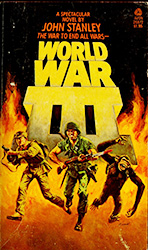
World War III
aka: NAPALM SUNDAY
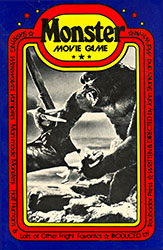
The Monster
Movie Game
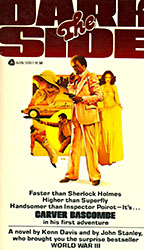
The Dark Side
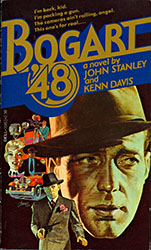
Bogart '48
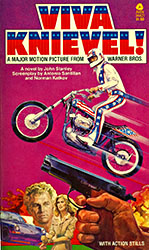
Viva Knievel
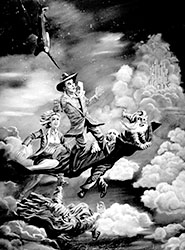
Lost in Time and Space
with Lefty Feep
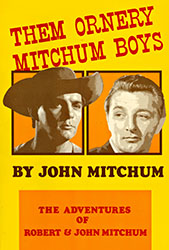
Them Ornery
Mitchum Boys